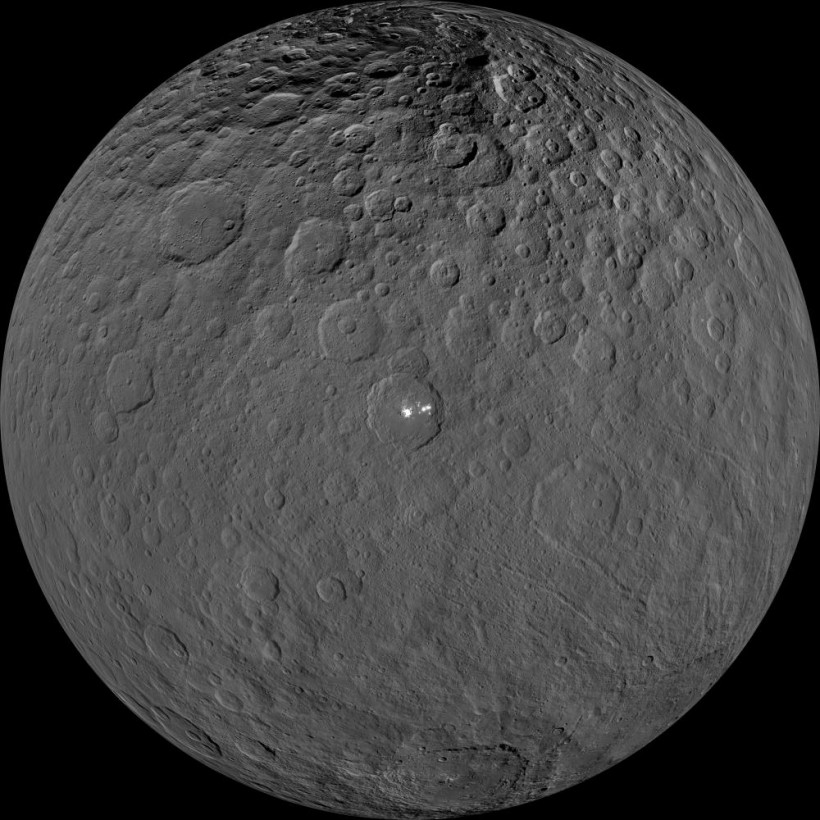Ceres was initially discovered by Giuseppe Piazzi in 1801, and he assumed it was the "missing" planet between Mars and Jupiter. However, Pallas, Juno, and Vesta were also identified in the region after a few years and were named planets as well. As a result of the growing number of heavenly bodies found in this region, astronomers agreed to reclassify some of the extraterrestrial bodies because they don't quite fit the description of planets.
Astronomers concluded that these objects were asteroids by 1863, and the area was dubbed the asteroid belt.
But this classification changed again after 140 years.
So what exactly is Ceres?
While you can find specific details about this celestial body on NASA [1,2], we've put together a list of 10 Things to Know About Ceres that includes facts and fascinating information that you should definitely know about this mysterious object!

This orthographic projection shows dwarf planet Ceres as seen by NASA's Dawn spacecraft. The projection is centered on Occator Crater, home to the brightest area on Ceres.
Who is Ceres named after?
Ceres is named after Ceres, the Roman goddess of harvests and grain crops. Cereal is derived from the same name.
Its Size Is 14 Times As Pluto's
Ceres has a radius of only 296 miles (476 km). Even though Ceres makes up 25% of the overall mass of the asteroid belt, Pluto is 14 times bigger. Ceres would be around the size of a poppy seed if Earth were the size of a nickel.
Revolution and Rotation
Ceres completes one round around the Sun every 1,682 Earth days, or 4.6 Earth years. Meanwhile, it completes one rotation around its axis every 9 hours.
Changed From Asteroid to a Planet
Ceres is so larger and different from its neighbors that the International Astronomical Union (IAU) concluded in 2006 that it was big enough to be classified as a dwarf planet. Ceres is the only dwarf planet in the inner solar system, and it is the largest object in the asteroid belt between Mars and Jupiter.
Does It Have Any Moons or Rings?
There are no moons or rings on Ceres.
First Dwarf Planet to be Visited by a Spacecraft
According to earthsky.org, Ceres was the first dwarf planet to be orbited by a spacecraft from 2015 to 2018, when NASA's Dawn mission peered down at Ceres and revealed some of its mysteries. Dawn was the first spacecraft to visit a dwarf planet when it arrived at Ceres. Dawn arrived in 2015 to investigate the surface, composition, and history of the planet.
Is Ceres Active or Inactive?
Ceres is geologically active-at least it was until recently, according to Dawn.
Is There Life on Ceres?
Scientists would like to look for indications of life on the dwarf planet and Dawn might have an answer to this as it discovered organics on Ceres. It possesses water, something many other worlds lack. Dawn also supported the theory that dwarf planets might have - and possibly still do - host oceans for long periods of time.
Dawn's Legacy
Dawn was the first mission to orbit two celestial bodies (Vesta and Ceres). Dawn landed on Vesta, the second-largest world in the main asteroid belt, in 2011. Meanwhile, the spacecraft was sent into orbit around Ceres in 2015.
Up to the Last Drop
Dawn collected science data on Ceres and was sent back to Earth until the spacecraft ran out of fuel.
Related Article: Wandering Black Hole May be the Smallest One Discovered - How Did the Scientists Spot It?














